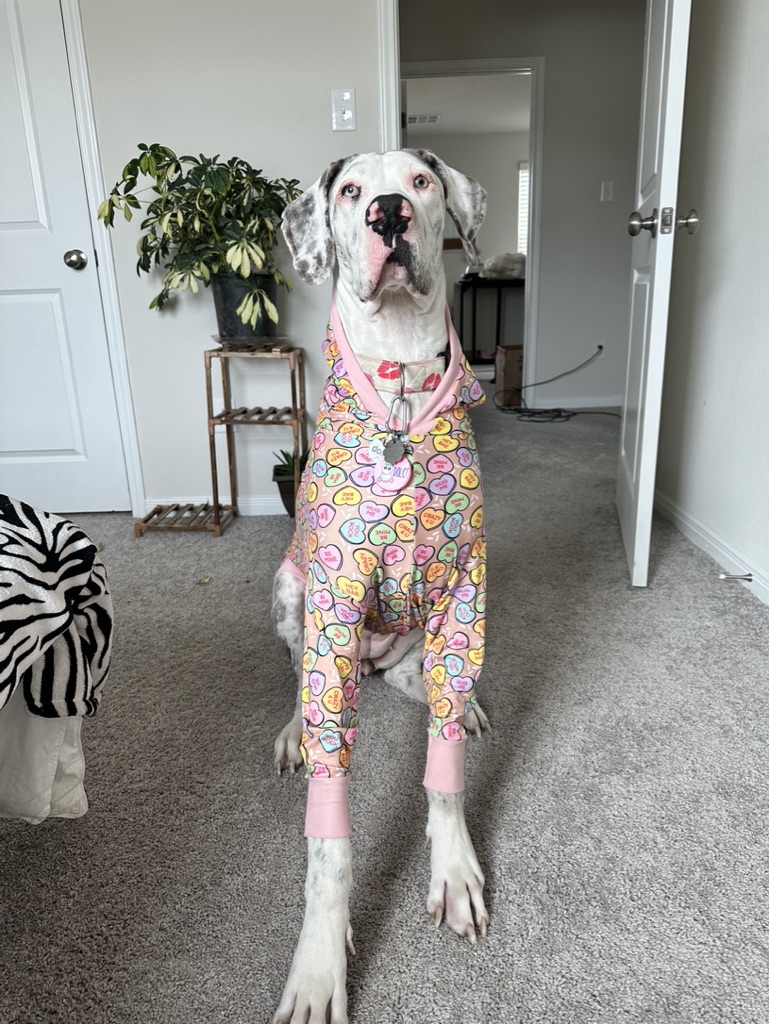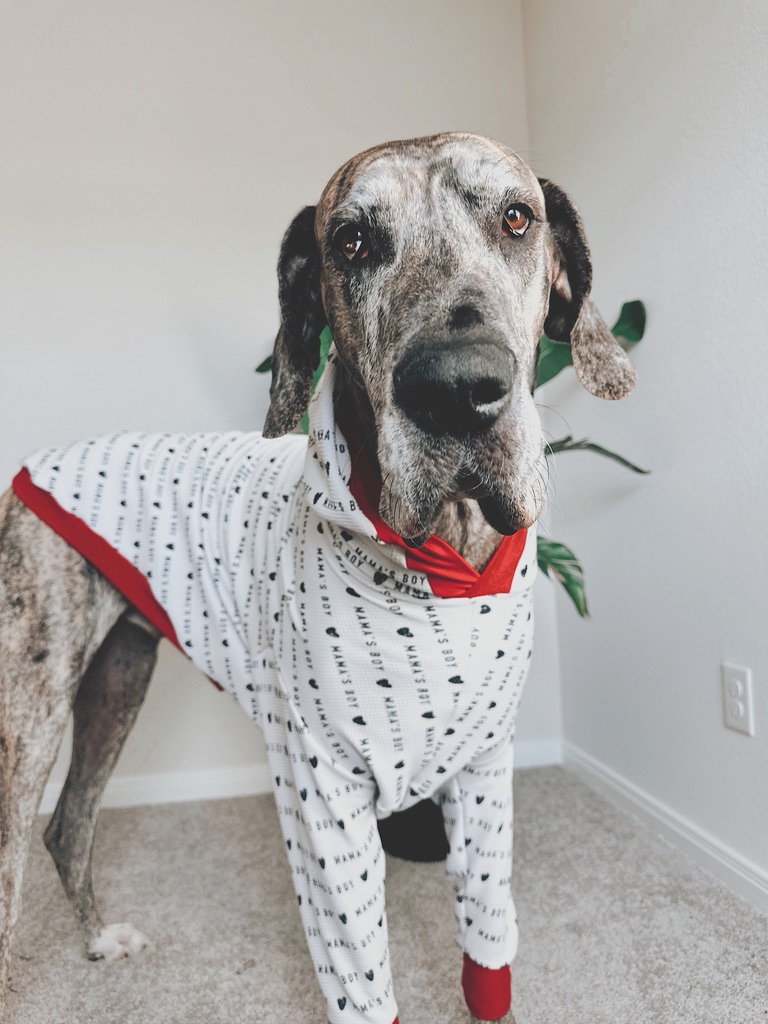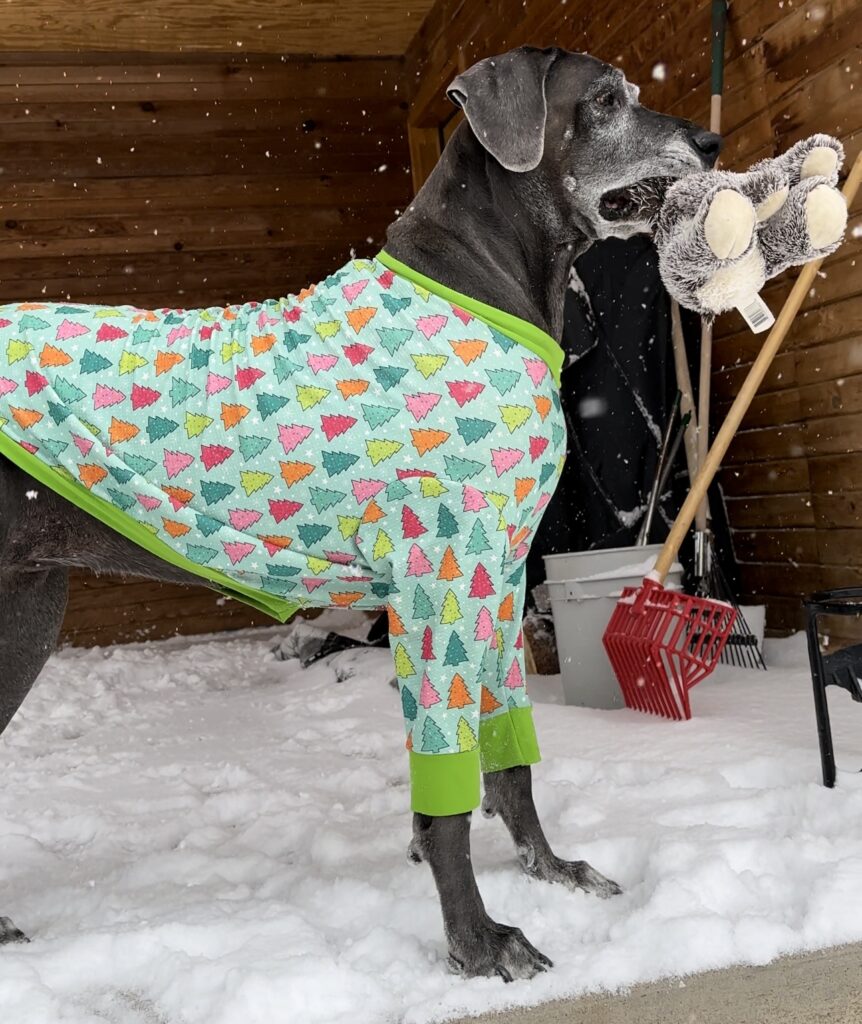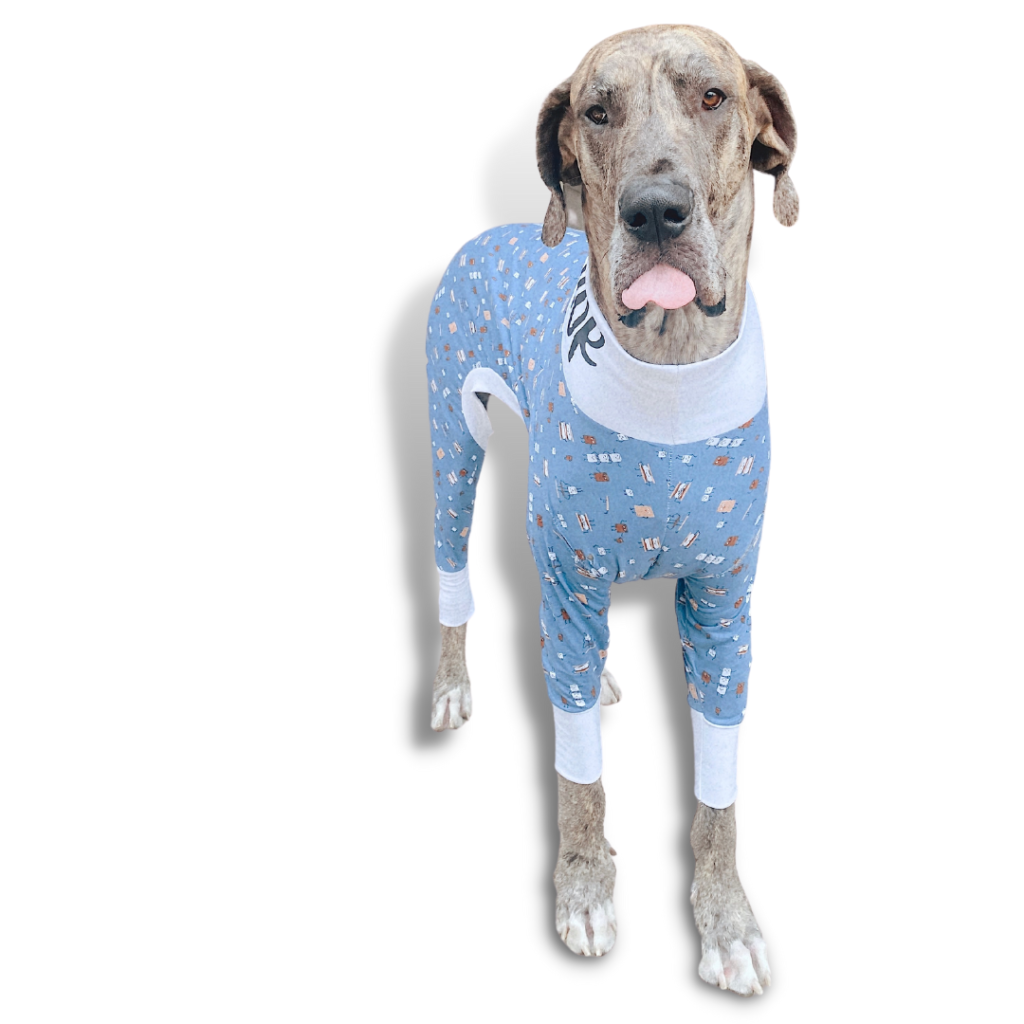Explore how dog jammies can help maintain your canine companion’s optimal body temperature, providing comfort and protection against the elements, no matter the season.

Table Of Contents
- Introduction
- Understanding Dog Body Temperature
- Ideal Room Temperature For Dogs
- How Dog Jammies Shield Against Winter’s Chill
- Dog Jammies For Great Danes + More!
- Protecting Against the Elements With Dog Jammies
- The Role of Dog Jammies in Temperature Regulation
- Additional Benefits of Dog Jammies
- Conclusion
Introduction
Have you ever wondered if your dog gets cold? If so, you’re not alone! When I first noticed my Great Dane, Dior, shivering as he played for hours in the freshly fallen snow on our family ranch, I knew I had to find a solution. That’s how the first pair of Dymonds Co dog jammies came to life. And as it turns out, I was onto something much bigger.
As a dog owner, you’re not just a best friend to your pooch—you’re also the guardian of their health and comfort. One of the most crucial, yet often overlooked, aspects of canine care is understanding and regulating your dog’s body temperature. Unlike humans, dogs have a narrower margin for their normal body temperature, typically between 101.0 and 102.5 degrees Fahrenheit. This delicate balance can be easily upset by environmental factors, which is why ensuring our dogs are comfortable, whether they’re lounging at home or romping through the snow, is so essential.
The temperature of their surroundings plays a pivotal role. Most dogs thrive in a home environment that’s maintained between 68 and 72 degrees. However, what happens when the thermometer dips below that cozy range, or when the searing heat of summer sets in? For some breeds, particularly those like Great Danes with their single coats and lean builds, the answer doesn’t lie in their natural defenses.
That’s where dog jammies come in—combining style and function, they’re not just a fashion statement but a practical garment designed to help maintain your dog’s optimal body temperature. From providing an extra layer to guard against the chill to protecting their sensitive skin from the harsh rays of the sun, jammies can be a year-round ally in your pet’s comfort and health. In this post, we’ll explore how these cozy accessories can benefit dogs of all breeds and in all climates.

Section 1: Dog Body Temperature Basics
Every dog owner knows the importance of a wagging tail or a heartfelt bark, but there’s an essential sign of canine health that’s not always visible to the naked eye: body temperature. Understanding the baseline for your dog’s internal warmth is a vital part of pet care. Generally, a healthy dog’s body temperature will hover around 101.0 to 102.5 degrees Fahrenheit—a bit hotter than the human average.
Unlike people, dogs don’t sweat out excess heat. Instead, they pant to cool down, and they rely on a minimal amount of sweating through the pads of their paws. This system works well, but it also means that our canine companions are particularly sensitive to changes in activity level and outside temperatures.
When dogs are active, their muscles generate heat, which can cause their body temperature to rise. In a cooler environment, this isn’t typically a problem as they can regulate their temperature quite effectively. However, in warmer settings, especially during vigorous exercise, they can quickly overheat if care isn’t taken to ensure they can cool down.
On the flip side, when the mercury drops, dogs can face challenges in keeping warm, especially if they are not active. This is particularly true for certain breeds with thin coats or less body fat. They can’t simply put on a sweater—though that’s where thoughtful owners with a supply of cozy jammies can make a world of difference.
In the following sections, we’ll delve into how various temperatures affect dogs differently and how the simple addition of dog jammies can provide comfort and protection in a range of climates.

Section 2: The Comfort Zone – Ideal Room Temperatures for Dogs
Creating a comfortable living space for your dog goes beyond a plush bed and an array of chew toys; it extends into the air they breathe and the ambient temperature that surrounds them. The sweet spot for indoor comfort lies between 68 and 72 degrees Fahrenheit. This range is often cited as the “thermoneutral zone,” where dogs can regulate their body temperature without expending extra energy to cool down or warm up.
Why is this range important? It’s in this zone that dogs are least likely to be stressed by the environment, which is crucial for their health and wellbeing. When the indoor thermometer reads within these limits, your furry friend can rest, play, and go about their daily routines without the risk of thermal stress.
However, when the temperature falls below or rises above this comfort zone, risks emerge. Colder environments, especially those dipping below 45 degrees, can lead to a multitude of issues ranging from discomfort to hypothermia, particularly in dogs that are not bred for chilly climates. The signs of a dog being too cold can be subtle—shivering, lethargy, or hunching over—so it’s important to monitor them and provide warmth when necessary.
In contrast, excessive heat can cause overheating and heatstroke, a serious condition that requires immediate veterinary attention. The risks are higher in humid conditions where evaporation from panting is less effective, and in breeds prone to respiratory issues.
Understanding these risks underscores the importance of providing a regulated, comfortable environment for your dog. In the next section, we’ll look at how certain breeds, including the regal Great Dane, face specific challenges when it comes to temperature regulation and how dog jammies can be a beneficial tool in ensuring their comfort.

Section 3: How Dog Jammies Shield Against Winter’s Chill
As the chill of winter sets in, dog owners must turn a keen eye toward the thermometers. For our beloved pets, especially when temperatures fall below the 45 degrees Fahrenheit mark, the cold can be more than just uncomfortable—it can be dangerous. At these temperatures, the risk of hypothermia and frostbite in dogs climbs, particularly in those that lack a thick fur coat or substantial body fat for insulation.
Great Danes, for instance, are one such breed that exemplifies these vulnerabilities. These gentle giants are not only susceptible to the cold due to their single-layered coat but also because their lean bodies don’t store much fat, which serves as natural insulation for many animals. Similar breeds, like Whippets or Greyhounds, share these characteristics and consequently, the same risks in cold weather.
Even dogs that are typically more resistant to cold, such as Akitas, Huskies, and Malamutes, can face cold-weather challenges. No matter the breed, all dogs are at risk from common wintertime hazards. Antifreeze, often used in cold climates, can leak onto driveways and roads where its sweet taste can be enticing and deadly to dogs. Ice salts, too, pose a threat; they can irritate or burn a dog’s paws and can be harmful if ingested during post-walk grooming.
This is where protective clothing, such as dog jammies, comes into play. Not only can they provide an additional layer of much-needed warmth for breeds like Great Danes, but they can also protect the skin and fur from the chemical irritants that come with a wintry mix. You can ensure your furry friend stays warm with our premium fleece jammies, designed for maximum comfort and warmth. In the next section, we’ll explore the unique needs of Great Danes in both cold and warm conditions and how to mitigate them.

Section 4: Dog Jammies For Great Danes + More!
In the canine world, not all coats are created equal. Single-coated breeds like Great Danes, with their sleek and short fur, lack the undercoat that provides a built-in sweater for other breeds. This single layer of fur offers minimal insulation and makes it difficult for them to retain body heat. As majestic as they may appear, Great Danes are more vulnerable to the cold due to this anatomical feature. The cooler months can be particularly challenging for these gentle giants, as they simply do not have the natural means to fend off the chill that nips at their thin coats.
The impact of cold weather is further exacerbated by low humidity levels that often accompany winter’s frosty bite. For breeds with single coats, the dry air can strip moisture from their skin and fur, leading to dryness, flaking, and discomfort. This can weaken their already limited defenses against the cold, making it even more crucial to provide additional sources of warmth and protection.
But it’s not only the cold that poses a threat to these large, muscular dogs. Their size and physique mean that Great Danes also face challenges when temperatures climb. They can be prone to overheating because their body mass makes it harder to cool down efficiently. Extreme heat can be as perilous as the bitter cold, and it requires just as much attention and care to ensure these dogs’ safety and comfort.
Providing thermal aid through dog jammies can make a significant difference. Not only do they offer an extra layer of warmth against the cold, but they also serve as a barrier against harsh environmental factors. Moreover, in hotter months, light and breathable jammies, like our summer tees, can shield their skin from the sun and provide comfort without causing overheating. In the subsequent sections, we will look at how jammies can serve as a practical wardrobe addition to address both ends of the temperature spectrum for breeds like the Great Dane.

Section 5: Protecting Against the Elements With Dog Jammies
When it comes to battling the elements, the thickness and color of a dog’s fur play pivotal roles. Like Great Danes, dogs with lighter or thinner fur are less insulated and more prone to the effects of temperature extremes. In the summer months, this can mean an increased risk of sunburn, especially for dogs with a fair complexion or sparse fur covering. Vulnerable areas like the belly, which often has less fur, as well as the nose and the tips of the ears, are particularly at risk for sun-related damage.
To safeguard these breeds from the cold, dog jammies can provide much-needed warmth. But beyond just warmth, they can also offer protection from the sun’s harsh rays. As with any pet clothing, the key is the material. For summer wear, you’ll find our knit material is lightweight and breathable to cover sensitive areas without causing overheating.
For the cold, snoods are a superb accessory to cover a dog’s ears, which are susceptible to frostbite during chilly walks.on the flip side a pet-safe sunscreen is a must for exposed areas like the nose, and avoiding the midday sun when UV rays are strongest is a wise move.

Section 6: The Role of Dog Jammies in Temperature Regulation
In the quest to maintain a dog’s ideal body temperature, dog jammies emerge not just as a fashionable choice but as a functional necessity. These cozy garments are ingeniously designed to offer comfort and protection across a wide range of climates, making them an indispensable tool for any pet owner’s arsenal.
For breeds lacking the natural insulation of a thick fur coat, dog jammies provide an essential layer of warmth that mimics the missing undercoat. This added insulation helps to retain body heat, ensuring that these dogs can maintain a comfortable temperature even when the thermometer dips. It’s akin to us donning an extra sweater on a chilly day — a simple yet effective solution to stave off the cold.
However, the magic of dog jammies lies not just in their ability to warm but also in their construction from materials that promote breathability. The choice of fabric is crucial; too heavy, and it can lead to overheating, too light, and it might not provide adequate warmth. The ideal dog jammies are made from materials that allow for air circulation, helping to regulate body temperature by letting excess heat escape when necessary and keeping the dog warm when the temperature falls.
Moreover, these materials are selected for their comfort and flexibility, accommodating a dog’s every move without restriction. Whether it’s a sprint across the park or a cozy nap on the couch, jammies should support the dog’s natural behavior. From jersey knit blends in the summer to fleece in the winter, each fabric choice is tailored to suit the seasonal needs, ensuring that your dog is not only stylish but also able to maintain an optimal temperature throughout the year.
In essence, dog jammies stand at the crossroads of fashion and function. By providing an extra layer of insulation for breeds with lighter coats and utilizing materials that offer breathability and comfort, these garments play a critical role in temperature regulation. They ensure that all dogs, regardless of breed or coat type, can enjoy the great outdoors and cozy indoors in comfort and style.

Section 7: Additional Benefits of Dog Jammies
While the primary purpose of this blog was to inform you on how dog jammies help regulate body temperature, their benefits extend well beyond just keeping your dog warm or cool. These versatile garments offer a multitude of advantages for both pets and their owners, making them an all-around valuable addition to any dog’s wardrobe.
- Reducing Shedding and Dander: For pet owners, managing shedding and dander is a constant battle. Dog jammies can significantly mitigate this issue by trapping loose fur and skin flakes within the fabric. This not only keeps your home cleaner but also helps to improve air quality, a particularly welcome benefit for allergy sufferers.
- Alleviating Anxiety: Many dogs experience anxiety, whether from environmental factors, separation, or specific triggers like thunderstorms. Much like weighted blankets for humans, the gentle pressure provided by dog jammies can offer a comforting sense of security to anxious dogs, helping to calm their nerves in stressful situations. Discover how jammies can help your anxious dog.
- Keeping Your Dog Cleaner for Longer: Outdoor play is crucial for a dog’s health and happiness, but it often means dirt, mud, and other outdoor grime. Dog jammies act as a barrier between your dog’s fur and the elements, keeping them cleaner and reducing the frequency of baths needed. This is especially beneficial for dogs who love to explore the great outdoors, regardless of the weather.
- Preventing Bug Bites and Skin Irritants: In warmer months, dogs are susceptible to bug bites and skin irritants from outdoor allergens. Dog jammies provide a physical barrier against fleas, ticks, and other pests, while also shielding sensitive skin from plants and grasses that may cause irritation or allergic reactions.
In addition to these practical benefits, dog jammies also foster a deeper bond between pets and their owners. Dressing your dog in jammies can be a shared experience that strengthens your connection, filled with fun and laughter. It’s an expression of care that goes beyond basic needs, showing your pet just how much they’re loved and cherished.


Conclusion
Throughout this exploration of canine care and comfort, we’ve uncovered the critical role that dog jammies play in our dogs’ lives, from maintaining their ideal body temperature to protecting them against the elements. We’ve delved into the specific needs of breeds like Great Danes, which, despite their size, are vulnerable to both the cold of winter and the heat of summer due to their single-layer coats. We’ve also highlighted the dangers that extreme temperatures pose, from the risk of hypothermia and frostbite in the cold to the dangers of overheating and sunburn in the heat.
Dog jammies emerge as a hero in this narrative, offering a stylish and practical solution to a range of challenges. Beyond just regulating temperature, they serve to reduce shedding and dander, alleviate anxiety, keep our furry friends cleaner, and protect against bugs and outdoor allergens. These garments represent a simple yet effective way to enhance our pets’ comfort and well-being, ensuring they remain happy, healthy, and by our sides for many years to come.
Dog jammies are more than a mere accessory; they are a testament to the care and love we have for our pets, providing them with protection, comfort, and style regardless of the season.
With that, we invite you to explore our selection of dog jammies, designed and handmade by us with every breed and climate in mind. Whether you’re looking to keep your pooch warm during chilly evenings or protect them from the summer sun, we have something for every need and style.
Don’t keep this knowledge to yourself—share this article with fellow dog owners and help spread the word about the benefits of dog jammies. Together, we can ensure that all our four-legged friends enjoy the comfort and protection they deserve.
Happy pet parenting, and here’s to many more cozy moments with your beloved dogs!

-
Help Dior Fight Osteosarcoma 🐾
Dior has been part of our family since he was 12 weeks old, and anyone who has met him knows—he’s truly one of a kind. From the way he comforts without words to his goofy personality that keeps us laughing, Dior is more than just a pet… he’s my service dog, pandemic puppy, deployment buddy,…Read…
-
June 2, 2025 – Surgery Scheduled!
This morning we had our initial appointment at Main Street Veterinary Clinic—and I left feeling more at peace than I have in weeks. I already felt reassured after speaking with Dr. Hunter on the phone last week, but after meeting her, Dr. Ford (the orthopedic surgeon), and the rest of the MSVC staff in person,…Read…
-
May 29, 2025 – Dallas, Detours & Decisions
We hit the road early this morning for our appointment at UT Southwestern in Dallas. Bright-eyed, bushy-tailed, and out the door by 7:30 AM for our 11:00 AM consult. We have to pass a Buc-ee’s along the way so naturally, we had to stop. Blue sodas, brisket breakfast tacos, and a last-minute bag of nuggets…Read…
-
The Dior Files: What We’ve Used (and Why) to Support His Body
One of the hardest parts about getting Dior’s osteosarcoma diagnosis has been figuring everything out as we go. There’s no clear playbook. Just a lot of love, research, late-night deep dives, and tough choices. I wanted to put together a list of everything we’ve done (and are still doing) to support Dior’s body before surgery,…Read…

It supports body temperature for your Dane, not the Hooman. If you are Hooman and a Dane sits or lays on you, your body temperature is no longer ideal!